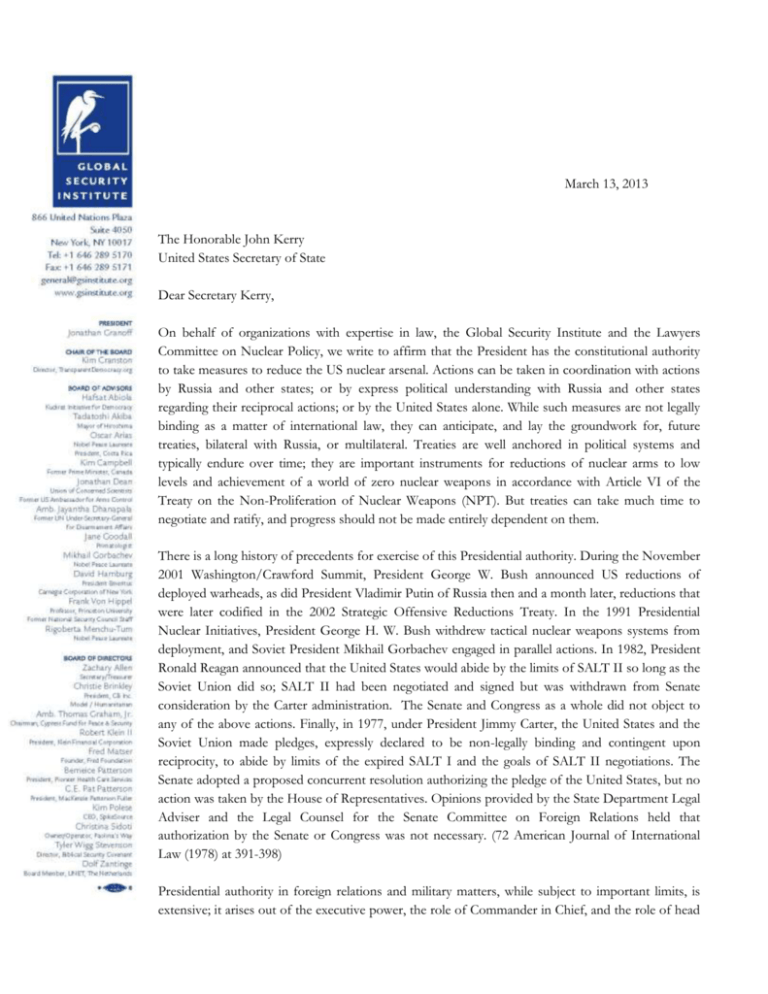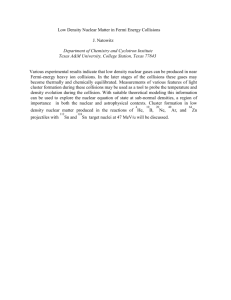March 13, 2013 The Honorable John Kerry United States Secretary
advertisement

March 13, 2013 The Honorable John Kerry United States Secretary of State Dear Secretary Kerry, On behalf of organizations with expertise in law, the Global Security Institute and the Lawyers Committee on Nuclear Policy, we write to affirm that the President has the constitutional authority to take measures to reduce the US nuclear arsenal. Actions can be taken in coordination with actions by Russia and other states; or by express political understanding with Russia and other states regarding their reciprocal actions; or by the United States alone. While such measures are not legally binding as a matter of international law, they can anticipate, and lay the groundwork for, future treaties, bilateral with Russia, or multilateral. Treaties are well anchored in political systems and typically endure over time; they are important instruments for reductions of nuclear arms to low levels and achievement of a world of zero nuclear weapons in accordance with Article VI of the Treaty on the Non-Proliferation of Nuclear Weapons (NPT). But treaties can take much time to negotiate and ratify, and progress should not be made entirely dependent on them. There is a long history of precedents for exercise of this Presidential authority. During the November 2001 Washington/Crawford Summit, President George W. Bush announced US reductions of deployed warheads, as did President Vladimir Putin of Russia then and a month later, reductions that were later codified in the 2002 Strategic Offensive Reductions Treaty. In the 1991 Presidential Nuclear Initiatives, President George H. W. Bush withdrew tactical nuclear weapons systems from deployment, and Soviet President Mikhail Gorbachev engaged in parallel actions. In 1982, President Ronald Reagan announced that the United States would abide by the limits of SALT II so long as the Soviet Union did so; SALT II had been negotiated and signed but was withdrawn from Senate consideration by the Carter administration. The Senate and Congress as a whole did not object to any of the above actions. Finally, in 1977, under President Jimmy Carter, the United States and the Soviet Union made pledges, expressly declared to be non-legally binding and contingent upon reciprocity, to abide by limits of the expired SALT I and the goals of SALT II negotiations. The Senate adopted a proposed concurrent resolution authorizing the pledge of the United States, but no action was taken by the House of Representatives. Opinions provided by the State Department Legal Adviser and the Legal Counsel for the Senate Committee on Foreign Relations held that authorization by the Senate or Congress was not necessary. (72 American Journal of International Law (1978) at 391-398) Presidential authority in foreign relations and military matters, while subject to important limits, is extensive; it arises out of the executive power, the role of Commander in Chief, and the role of head 1 of state. Moreover, the long and consistent practice of presidential actions, not required by international legal obligation, to limit and reduce the nuclear arsenal constitutes what Justice Felix Frankfurter described as “a systematic, unbroken, executive practice, long pursued to the knowledge of the Congress and never before questioned,” which “may be treated as a gloss on ‘executive Power’ vested in the President by § 1 of Art. II” of the Constitution. (Concurring opinion, Youngstown Sheet & Tube Co. v. Sawyer, 343 U.S. 579, 610-611 (1952)) Further, reductions in nuclear arsenals generally contribute to implementation of Article VI of the NPT and specific commitments regarding Article VI that the United States and other NPT-acknowledged nuclear weapons states have made within the NPT Review Process. The inherent Presidential authority to take nonobligatory actions to reduce the nuclear arsenal is amplified by the fact that such actions contribute to fulfillment of a treaty of the United States. The longstanding statutory provision regarding the Congressional role in approving obligatory reductions in US arms does not impair the President’s authority to take actions not mandated by treaty or other international legal obligation. In its current form, the provision reads: No action shall be taken pursuant to this chapter [Arms Control and Disarmament] or any other Act that would obligate the United States to reduce or limit the Armed Forces or armaments of the United States in a militarily significant manner, except pursuant to the treaty-making power of the President set forth in Article II, Section 2, Clause 2 of the Constitution or unless authorized by the enactment of further affirmative legislation by the Congress of the United States. (22 U.S.C.A. § 2573) The provision does not purport to limit the constitutional power of the President to take nonobligatory measures to regulate the nuclear stockpile and other armaments, as has been understood with respect to the above-listed actions. It is worth noting that when the provision, with slightly different wording, was originally adopted in 1961, the Senate did so “with the understanding that its language does not interfere in any way with the President’s authority to control the size of U.S. Armed Forces under existing law.” (Arms Control and Disarmament Act Conference Report of 1961, Conf. Rep. No. 87-1263) The provision also does not require that obligatory reductions on armaments be undertaken only in a treaty approved by the Senate; rather it says that they alternatively may be agreed to if authorized by Congressional legislation. That was the approach taken with SALT I, the 1972 Interim Agreement on the Limitation of Strategic Offensive Arms, an executive agreement which was subsequently approved and authorized by a joint resolution of Congress. Thus in addition to the options outlined at the outset of this letter, the President may enter into an executive agreement on reduction of nuclear arsenals so long as it is authorized, subsequently or previously, by Congress. It is the case, however, that since SALT I binding nuclear arms control agreements have been handled as treaties subject to Senate consent. It is not the purpose of this letter to make a recommendation regarding the options for reductions in nuclear arsenals. We do want to observe that should it be determined that it is desirable to implement United States and Russian reductions through means not now involving a treaty or executive agreement, the 1991 Presidential Nuclear Initiatives (PNIs) and the 1977 pledges regarding extension of SALT I/goals of SALT II are useful precedents. The PNIs are a model of coordinated, nonbinding, actions, which are simply announced. In the pledge approach, reciprocal pledges could, as 2 appropriate, declare: that the pledges are not legally binding; that measures to be undertaken are in anticipation of a future legally binding agreement; that the measures will be effective as long as needed, provided reciprocal action is taken; and that the measures will be monitored and verified through existing START verification mechanisms and subject to the direction of the START Bilateral Consultative Commission. While the pledges would not be legally binding, as then Secretary of State Henry Kissinger testified before the Senate in the 1975 Sinai Disengagement Agreements Hearings, that does not signify that the United States would be “morally or politically free to act as if they did not exist. On the contrary, they are important statements of diplomatic policy and engage the good faith of the United States as long as the circumstances that gave rise to them continue.” We hope that you find this letter useful and would be pleased to elaborate the analysis set forth if desired. We strongly urge that the United States take the present opportunity to pursue with vigor a nuclear weapons-free world in accordance with the NPT obligation and President Barack Obama’s eloquent 2009 speech in Prague. Very truly yours, Jonathan Granoff, President, Global Security Institute (GSI) John Burroughs, Executive Director, Lawyers Committee on Nuclear Policy (LCNP) Kevin Krauss, Widener Law, Delaware, 2013; 2012 Global Law Extern for GSI and LCNP; StudentPresident of International Law Students Association (identification only) CC: Rose Gottemoeller, Acting Under Secretary of State for Arms Control and International Security Mary McLeod, Principal Deputy Legal Adviser, Department of State Thomas E. Donilon, National Security Advisor 3






![The Politics of Protest [week 3]](http://s2.studylib.net/store/data/005229111_1-9491ac8e8d24cc184a2c9020ba192c97-300x300.png)
